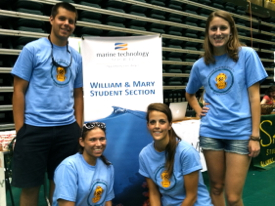Undergraduate studies, research in marine science show impressive gains
The William & Mary chapter of the Marine Science Society is only a year old, but it has already been honored with the Outstanding Student Section Award from the Marine Technology Society for 2012.
The award is one of several examples of success in undergraduate studies and research in marine science at William & Mary.
The Marine Science Society is a student section, or college chapter, of the Marine Technology Society (MTS), a professional organization of marine engineers and educators. The W&M chapter was created as a means for students interested in marine science to explore the many opportunities offered at William & Mary and the Virginia Institute of Marine Science (VIMS). The MTS presents its Outstanding Student Section Award to a university that has been recognized as home to a very active and enthusiastic chapter.
Seth Theuerkauf ’12, founder of the William & Mary Marine Science Society, says that he is thrilled by the opportunities the Marine Science Society has been able to extend to its members.
“We participate in the seminars at VIMS, so it's a good way for students on campus to get involved with VIMS, get involved in research there, and get to know different professors,” said Theuerkauf.
Many, but not all, of the members of the William & Mary MTS chapter are pursuing the university’s new marine sciences minor, he added. At the Student Activities Fair this fall, the Marine Science Society added more than 75 students to its roster. Along with the growth of the minor program, Theuerkauf believes the popularity of this relatively new club indicates an increase in interest in marine science among William & Mary undergraduates.
 The marine science minor, introduced in 2010, is already
extremely popular among undergraduate students. VIMS professor Liz Canuel,
co-director of the marine science minor, says she is pleased by the expansion
of the program and the increase in interest over the two years since its
inception.
The marine science minor, introduced in 2010, is already
extremely popular among undergraduate students. VIMS professor Liz Canuel,
co-director of the marine science minor, says she is pleased by the expansion
of the program and the increase in interest over the two years since its
inception.
“Overall, interest in the undergraduate minor in marine science is strong and growing. We have also made a concerted effort to adjust the minor to reach undergraduates during the early stages of their careers at William & Mary,” said Canuel.
Canuel added that one of the core courses for the marine science minor, MSCI 330, has had a dramatic increase in the number of students enrolled, growing from 50 to 70 available seats. The minor introduces students to the global importance of marine ecosystems, their role in driving global biogeochemical cycles, and their significance to society as a source of food and in regulating climate.
The minor is jointly offered by VIMS and Arts & Sciences, allowing students to take courses on both the Williamsburg and Gloucester Point campuses. Undergraduates are able to use the resources of both campuses to explore a field that is rarely offered at the undergraduate level, and their proximity to Chesapeake Bay allows for hands-on learning experiences.
“I think it really encapsulates the enthusiasm of students for marine science on the Williamsburg campus,” Canuel said. “The students are enjoying the opportunities that this partnership between VIMS and Arts & Sciences has brought about through the undergraduate minor.”
Canuel said the program has also increased freshman participation by allowing freshman to enroll in MSCI 330 during their first year, offering a popular freshman seminar and offering a new course called Marine Science Mash-up that is open to freshmen.
Dr. Heather Macdonald, geology professor and faculty sponsor of the Marine Science Society, was a founder of the marine science minor. Macdonald said she is optimistic about the program’s future success, citing accomplishments of the Marine Science Society and the influx of opportunities being offered to undergraduates.
Assistant professor of biology Jon Allen, the other co-director of the marine science minor, points to other successes of undergraduate study and research in marine sciences. Holly Blackburn ’13 was honored for having the best poster presentation at the 41st annual Benthic Ecology Meeting last spring. Allen points out that Blackburn’s poster on cloning in larval sea stars beat out a field of around 150 other presenters, including many from Master’s and Ph.D. programs.
“I was excited just to attend a conference, but to hear from distinguished marine biologists that my research is interesting and worth acknowledging was an overwhelming honor,” Blackburn said.
In addition, Daniel Schwab ’12 was awarded a scholarship through the prestigious and highly competitive Graduate Research Fellowship Program (GRFP) of the National Science Foundation. Allen notes that Schwab will receive more than $100,000 over three years in support of his graduate study. At William & Mary, Schwab was an active researcher, starting with beetles in the entomology lab of Norman Fashing and then doing marine science research on the evolution and ecology of marine mud snails in Virginia and Maine. Supported by his GRFP grant, Schwab is now enrolled in a biology Ph.D. program at Indiana University.
“This award capped a long and extremely productive four years of undergraduate research by Daniel,” Allen said. “It is emblematic of the kind of success that William & Mary students can achieve when given the resources to conduct meaningful research.”
Theuerkauf believes undergraduates in the marine science program have a lot to look forward to in the coming years.
“It’s really blossoming into something that's special. It makes William & Mary unique because we’re one of the only schools in the area that has a marine science program,” said Theuerkauf.
